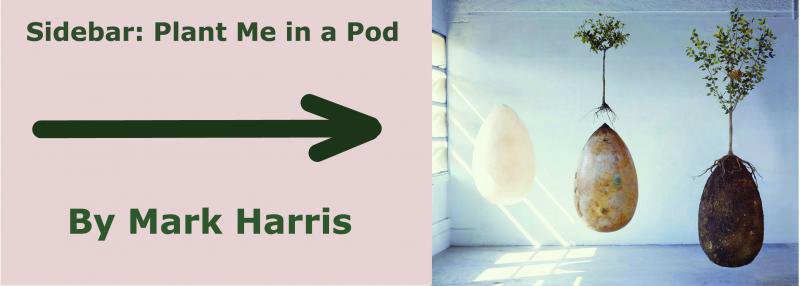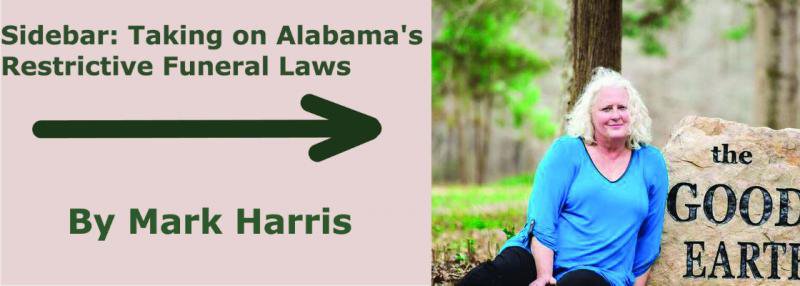
Illustration by Joe Anderson
Shelia Champion wasn’t surprised when she got the call saying her father had died. Her father, “Buster” Stice, a one-time cattleman from Stockton, Kansas, was almost eighty-six by then and in hospice care with advanced prostate cancer. On her last visit weeks before, Champion had been shocked at how bad her father looked. As she hugged him before heading back to Alabama, she suspected it would be their last goodbye.
Yet while Stice’s death in July 2010 had been expected, what happened afterward, at his funeral, was not. “I was shocked by how sterile and impersonal it was,” Champion says. At the funeral home chapel, she and her family were herded into an alcove, shielded from other mourners by a curtain, while a preacher who hardly knew her father offered platitudes.
She also thought the burial service at Stockton’s “cookie-cutter cemetery” was bland as it was brief, with the casket left suspended above the grave as everyone wandered off. “I thought, ‘Oh, my God. We’ve reached a point where we don’t let a feeling in,’ ” Champion says, recalling the event six years later. “It was like we were all pretending that Dad hadn’t died.”
Then there was the bill: $12,500, a sum Champion thought outrageous. “Talk about a waste,” she says. “All that money and no one knows or cares if Dad’s casket is dry or if his vault is crumbling. It’s all irrelevant.”
Back in Hazel Green, Alabama, mourning her loss, Champion found herself imagining the funeral she wished her father had had. Instead of his black suit, they’d have buried him in his overalls, like the ones he worked in his whole life. At a grave dug by one of the brothers, they’d have then toasted the “ornery old cuss” with a Bloody Mary, the drink Buster downed at breakfast every morning. “Anything,” says Champion, “to make it more authentic.”
At some point in Champion’s musings, an idea formed: Why not help others arrange for the kind of authentic sendoff her family hadn’t been able to give her dad? In March of 2016, Champion, a sixty-four-year-old retiree, turned that notion into a second career, opening the first freestanding natural cemetery in Alabama. Situated on five acres in farm country north of Huntsville, The Good Earth Burial Ground—named for the classic Pearl S. Buck novel—seeks to bring death back down to earth, says Champion. Thus, there is no embalming, no metal caskets, no burial vaults.
“Just the body going into the ground,” she says, “to decompose in a manner more in line with what nature has in mind.” At $1,800 on average for a plot, and far fewer fees than the typical funeral and burial, a natural return here is also more in line with a family’s bottom line.
In the end, The Good Earth seeks to bring families into closer engagement with both the dead and the natural cycle of life. When Champion and I talked this spring, she was still anticipating her first burial, but already had a vision for how it would go.
From the entrance, family members might carry the casket to the grave, and afterward all help lower it into the earth. Anyone could take a turn with a shovel and fill the grave. Funerals could be held beforehand at home. Certain rituals would develop over time. Whatever they are, Champion says, they won’t be the “expensive, sterile, one-size fits all rituals,” like the ones she observed with her father. “I’ll tell families: ‘Do whatever to make it real.’ ”
The idea of green burial—that is, the vaultless burial of an unembalmed body, wrapped in nothing but a shroud or laid into a biodegradable container—is hardly new, of course. For most of human history, it was common practice, the default, not the exception; Orthodox Jews and Muslims have been doing it for centuries. In the first 150 years of this country’s history, what we now call green—or natural—burial was simply the way the dead were laid to rest.
A number of events in the mid-1800s conspired to transform that spare burial of old into the elaborate—and expensive—process it is today. There was the rise of the middle class, the industrializing of the country, and, most notably, the Civil War, which introduced embalming as a means of preserving soldiers’ remains for the often long train ride home, a practice that soon became de rigueur. Shelia Champion’s work joins her to a movement that’s looking to reclaim those early burial traditions and return the American way of death to its rightful natural roots.
The movement is young but already taking hold. “We’ve made a lot of progress in twenty years,” says Billy Campbell, a family physician who in 1998 opened Ramsey Creek Preserve, an ecological burial ground on thirty-three acres of mostly pine forest in South Carolina. It was, at the time, the only green cemetery in the United States. Now it’s one of about 140. The nonprofit Green Burial Council, which sets standards for natural cemeteries, has charted a similar rise. In 2006, only one cemetery had earned its green stamp of approval. Since then, the group has certified nearly sixty.
A survey conducted last year by the Funeral and Memorial Information Council, a clearinghouse of news about the industry, found that a whopping 65 percent of those aged forty and older—nearly 100 million Americans in all—are “interested” in green funeral options. Of course, there’s no telling for certain how much of that interest will translate into action. But if even a quarter of them follow through, many more future funerals and burials will resemble the old, traditional green ones.
Katrina Spade, founder of the Urban Death Project, which promotes the composting of human remains, isn’t surprised. “The conventional funeral is failing us on almost every front,” she says. “It’s not environmentally friendly. It’s not economically accessible. Its spaces are dismal. To top it all off, it doesn’t hold much meaning for many people. The model is ridiculous.”
Enter green burial, which represents just about everything the conventional sendoff does not. It’s clearly better for the environment. It’s inexpensive, generally running into the low thousands of dollars, versus the roughly $12,000 average cost for a traditional funeral and burial. It is often conducted in bucolic environs. And for many, the experience is more meaningful.
“In a green burial, the family and the community most often journey with the body to the grave site,” says Suzanne Kelly, author of Greening Death. “They see the mound of dirt. They can look into the grave and fill it in. Those rituals connect us to each other, to the earth, and to death more generally.” By participating in the burial, not just passively observing it, she argues, we’re reminded that our own earthly remains will one day make that same journey back to the elements from which we all spring and, ultimately, to which we all belong.
Take away the fancy casket, vault, and chemical embalming, and you cut deep into the bottom line of a $16 billion business that is the modern funeral industry. So you might expect funeral directors to push back against the green burial trend.
At first, some did. In 2008, the National Funeral Directors Association published a green burial form online for families to sign (or at least read), warning them of possible health risks from handling unembalmed bodies and carrying defective green caskets. When one consumer advocate called out the trade group for trying to “scare” families and funeral directors away from pursuing green burial, the form disappeared from its web page.
Campbell, for his part, remembers the early years of the movement, when he’d hear that some funeral director or another had tried to deter families from burying at Ramsey Creek because it “just abandoned bodies out in the woods.”
Such derision doesn’t happen much anymore, he says. Perhaps that’s because, after two decades in operation, Campbell’s cemetery has become the final destination of enough prominent locals that woodland burial is becoming “respectable.” Increasingly, it’s also where the money is. “Now, the guys [funeral directors] in town are willing to work with us,” says Campbell. “They want the business.”
After almost half a lifetime in alternative burial, Campbell wishes the movement were growing faster: “We’re not turning the ship around on a dime.” Still, he knows the turn will come. The demographics alone predict as much. “If you look at the market and see who is choosing green burial, it’s mostly Baby Boomers,” says Campbell, a Boomer himself. “And, well, we’re getting older.”
Right behind them stand generations already primed to go out green. Lee Webster, a home funeral and green burial advocate in New Hampshire, has seen the evidence firsthand. “I speak to a lot of 30-somethings and also teach college students,” she says. “When I talk to them about green burial they just go, ‘Yeah, why would you do it any other way?’ ”
In mid-May, I check in with Shelia Champion to see how her green cemetery is coming along. As usual, Champion is upbeat. She’s getting good press, she tells me, and locals are calling to request tours.
A few days earlier, the meadow section of the grounds had gone in, thanks to a University of Alabama biology professor named Leland Cseke and a couple of his friends, who tilled the acre swath and sowed it with coneflower, fox sedge, and other wildflowers and grasses native to the region. Cseke is also applying permaculture design strategies to create a burial section in the wooded rear of the property. Champion is hopeful his concern for the ecology of The Good Earth—including plans to support local bluebird and warbler populations—will gain the cemetery certification as a “natural burial ground” from the Green Burial Council.
Champion’s got her own plans, as well. She’s thinking about putting tables near the entrance, so families can gather for picnics and “decorate” the graves of their loved ones. A separate pet cemetery is in the works. Goats are coming, too, as her eco-friendly approach to keeping weeds, brush, and poison ivy in check. Champion may even build a cottage on the grounds and take up residence as a steward.
Raised to see cemeteries as “spooky” and alienating, Champion is pleased to help regreen—and reclaim—the cemetery as a place of life. And, honestly, how scary could a graveyard named The Good Earth be, especially with a caretaker like Champion around? “I’ll be the old lady without the cats but with goats and a cemetery,” she says, with a hearty laugh. “My grandkids will love it.”
Mark Harris is the author of Grave Matters: A Journey Through the Modern Funeral Industry to a Natural Way of Burial.

